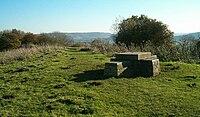| Site of Special Scientific Interest | |
 | |
| Location | Somerset |
|---|---|
| Grid reference | ST475346 |
| Coordinates | 51°06′30″N 2°45′05″W / 51.10828°N 2.75129°W |
| Interest | Biological |
| Area | 34.9 hectares (0.349 km2; 0.135 sq mi) |
| Notification | 1953 |
| Natural England website | |
Walton and Ivythorn Hills is a 34.9 hectares (86 acres) biological Site of Special Scientific Interest near Street at the south-eastern end of the Polden Hills in the English county of Somerset. Walton Hill is south of the village of Walton, and Ivythorn Hill is south of Street. Notified in 1953, the site is now owned and managed by the National Trust who acquired the freehold in 1988.
The hills which rise to 80 metres (260 ft) above Ordnance datum (mean sea level) are made up of limestone, rheatic clay and Keuper marl covered with calcareous grassland, scrubland and coppiced woodland. A quarry existed in the Middle Ages. This supports a variety of Butterflies, Leafhoppers, Spiders, Soldier Flies and Great Green Bush Crickets living on the vegetation. Notable buildings include Ivythorne Manor, which was originally built for Glastonbury Abbey, Walton windmill and a small sanatorium which became the first youth hostel in Somerset. In 1977 a short lived hippie camp was set up on Ivythorne Hill. The camp was a Free Festival to celebrate 7/7/77. The festival was attended by an estimated 3,000 people and was basically a one-day affair, with some people arriving early and the hangers on eventually evicted by the council.[1]
